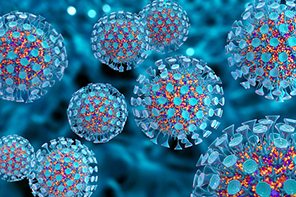

Author: Trevor Quirk
The human immune system is notorious for overreacting to common infections or going to war with harmless substances like dust or pollen. Its efforts to mount these defenses often exact a toll on the body it was trying to defend. In the February issue of Cell Host & Microbe, researchers from the University of Utah Health, Department of Human Genetics, have published an investigation into how one component of the immune system might have evolved to limit this collateral damage.
The OAS1 gene is found in most animals, and it is responsible for an immune pathway that fights infectious viruses like Dengue fever and West Nile. The gene encodes the enzyme 2’-5’-oligoadenylate synthetase 1 (OAS1), which detects invading viruses and activates another enzyme— RNase L — that destroys both viral and human RNA, eventually killing the infected cell.
Because activating the OAS1 immune pathway effectively damages the host, the gene could have evolved to diminish its own efficacy in order to enhance the host’s fitness. Previous studies have shown that mice lacking the ability to produce RNase L lived significantly longer than normal mice. However, the mice were also more susceptible to infection. These findings suggest that strengthening this immune response can in fact reduce evolutionary fitness in certain circumstances.
“OAS1 is among the most rapidly evolving genes in primate genomes,” said lead investigator Clayton Carey. “And yet there hasn’t been any study showing what the functional consequences of that evolution might be.”
The researchers examined how OAS1 evolved in a dozen primate species. By measuring the potency of the antiviral enzymes the gene encodes, they found OAS1 had undergone different mutations to restrict its effectiveness in several of the species. Some mutations were more extreme than others. Tamarin monkeys, for example, encode a version of OAS1 that cannot activate RNase L at all. The genomes of both humans and gorillas had alleles that drastically restricted the OAS1 immune response and that occurred at similar frequencies in their populations. Interestingly, the researchers discovered that these alleles were arrived at through very different evolutionary processes.
Carey said these findings could indicate “a common evolutionary pressure” to balance protection from viruses with the damage incurred by the immune pathway.
In order to quantify the OAS1 response in each primate, the researchers developed a novel technique using recombinant DNA and budding yeast. Yeast contains the same double-stranded RNA that activates OAS1. So when the OAS1 gene was expressed together with RNase L, it destroyed yeast RNA, limiting the growth of yeast cells. Using this method allowed them to compare the OAS1 genes of each species in a simplified manner: the less yeast growth, the stronger the immune response.
“Other researchers can use this as a tool to study these pathways,” Carey said.
Carey notes the host, in its long evolutionary conflict with pathogens, typically evolves increasingly powerful weapons to defend itself. In this case, he said, “it seems like the host is surrendering.” This insight might help explain why the human body sometimes tolerates latent viral infections, like the Epstein Barr virus or cytomegalovirus, which can eventually trigger certain autoimmune diseases.
###
In addition to Carey, co-authors were Juliane Cooper, Melissa Hartley, and Nels Elde, an H.A. & Edna Benning Presidential Endowed Chair, at University of Utah Health, and Apurva Govande and Philip Kranzusch from Harvard Medical School.
The research was supported by the National Institutes of Health, Burroughs Wellcome Fund, Claudia Adams Barr Program for Innovative Cancer Research, Richard and Susan Smith Family Foundation, and the National Science Foundation.